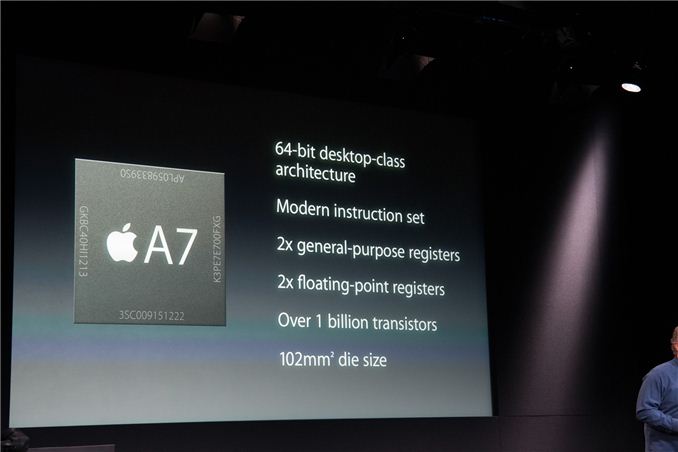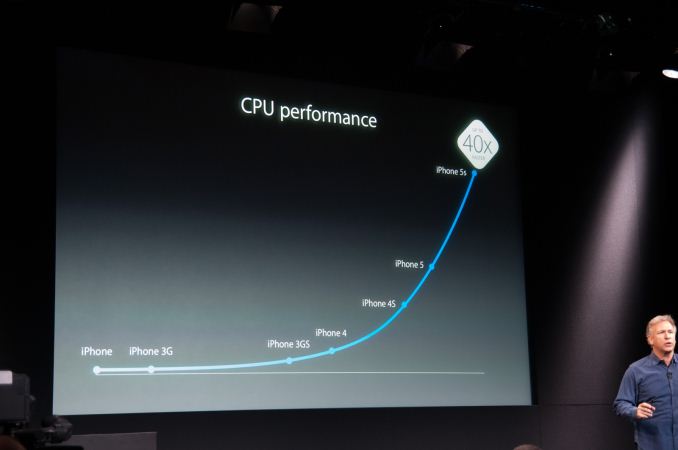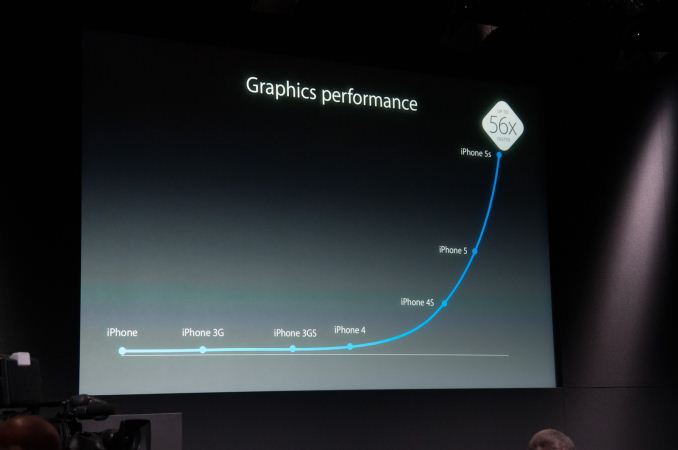Apple Announces A7, World's First 64-bit Smartphone SoC
by Anand Lal Shimpi on September 10, 2013 1:36 PM EST- Posted in
- Smartphones
- Apple
- Mobile
- SoCs
- iPhone 5S

Apple just announced the iPhones 5S featuring the A7 SoC, which is the world's first consumer ARM based SoC with 64-bit support. We're likely talking about an updated version of Apple's Swift microprocessor with ARMv8 support.
Check out our full coverage of Apple's Town Hall event in our live blog.












91 Comments
View All Comments
Daniel Egger - Tuesday, September 10, 2013 - link
Why would Apple require to sacrifice 32bit compatibility? I hope there's far more to that than just having fat binaries available, which would be a huge bloat for all users. For starters it might be a good win if they just optimized the system to scream in 64bit code while the applications continue to boast only 32bit.easp - Tuesday, September 10, 2013 - link
It surprised me as well, but 64bit isn't useless on a device with smaller memory.First, being able to operate on larger chunks of data is useful for a variety of tasks that have nothing to do with big integers.
Second, a larger unified address space could help with things like large memory mapped files in flash, which is already much larger than 4GB. I don't know, but I wonder if it is also useful for certainly security approaches, like address space randomization.
My best guess is that there are multiple factors behind making the move now: First and foremost, that they need to get their eventually. Given this, it is a question of timing. Arguments in favor of making the change sooner rather than latter: Minimizes one source of differences between OSX and iOS. Silicon design investment in new ISA, rather than legacy ISA. More GP registers, option for wider operations, "marketing." Arguments against would be increased cost due to die area and power consumption, it would seem that those considerations were less significant.
And then there is always the possibility that they are going to be using these chips in another class of device all together...
avishal - Sunday, September 15, 2013 - link
Great response!garadante - Tuesday, September 10, 2013 - link
Holy hell! Over 1 billion transistors? That's approaching the transistor count and die size of modern Intel desktop quad-core CPUs. Which I imagine would handily beat these 64-bit ARM cores in performance, though not necessarily power consumption. This is going to be an expensive chip to produce, that's for certain.darkcrayon - Tuesday, September 10, 2013 - link
That likely includes the entire SoC which is more than the CPU. I bet most of those transistors are part of the new GPU... Can't wait to see what that is.garadante - Tuesday, September 10, 2013 - link
The transistor count for 4 core Haswell with GT2 graphics and hyperthreading is somewhere around 1.4 billion transistors and a 177 mm^2 die I believe, looking at the article here on Anandtech regarding it. So it's really not ~too~ far off. Not sure how the graphics component fairs against whatever's in this A7 chip but I bet the CPU horsepower is far, far below even a very low power 4 core Haswell.stacey94 - Tuesday, September 10, 2013 - link
A ULV HD 4000 was about 3 times faster than the iPad 4's GPU in GLBenchmark 2.7... probably around 4-5X faster than the iPhone 5's based on results of comparable chips (Adreno 320).I'd imagine the gap is a bit smaller now, since Haswell GT2 doesn't double performance over the HD 4k.
Hubb1e - Tuesday, September 10, 2013 - link
but even ULV HD4000 had more power budget then a smartphone SOC. With more power budget, they could really ramp the frequencies, but Apple chooses to throw die area at their chips rather than frequency.easp - Tuesday, September 10, 2013 - link
Keep in mind that one of the things people spend transistors on in mobile SoCs is special-function blocks that do tasks that could be done on the other cores, but do it with less power.This is actually a technique that Intel has had to rely on heavily in order to be at all competitive with ARM SoC's in the phone and tablet space.
tipoo - Tuesday, September 10, 2013 - link
Higher clocked MP4 rather than MP3 maybe? 2x doesn't seem like it would need anything drastically new.